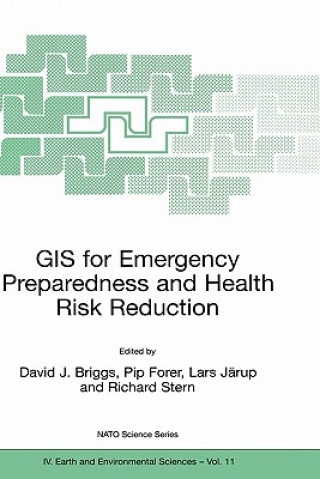
Kód: 01414910
GIS for Emergency Preparedness and Health Risk Reduction
Autor David J. Briggs, Pip Forer, Lars Järup, Richard Stern
Geographical Information Systems (GIS) have developed rapidly in recent years and now provide powerful tools for the capture, manipulation, integration, interrogation, modelling, analysis and visualisation of data - tools that are ... celý popis
- Jazyk:
 Angličtina
Angličtina - Vazba: Pevná
- Počet stran: 326
Nakladatelství: Springer-Verlag New York Inc., 2002
- Více informací o knize

5094 Kč

Skladem u dodavatele v malém množství
Odesíláme za 12-15 dnů
Potřebujete více kusů?Máte-li zájem o více kusů, prověřte, prosím, nejprve dostupnost titulu na naši zákaznické podpoře.
Přidat mezi přání
Mohlo by se vám také líbit
-

50 Fantastic Things to Do with Paint
512 Kč -

Critical Issues in Systems Theory and Practice
6578 Kč -

Artificial Neural Networks and Machine Learning -- ICANN 2012
1681 Kč -

Expert Evidence and Criminal Justice
5877 Kč -

Und Sagte Kein Einziges Wort
1761 Kč -

Elements of Plane and Solid Geometry
1179 Kč -

Technika Pracovný zošit pre 5. ročník ZŠ
177 Kč
Dárkový poukaz: Radost zaručena
- Darujte poukaz v libovolné hodnotě a my se postaráme o zbytek.
- Poukaz se vztahuje na celou naši nabídku.
- Elektronický poukaz vytisknete z e-mailu a můžete ihned darovat.
- Platnost poukazu je 12 měsíců od data vystavení.
Více informací o knize GIS for Emergency Preparedness and Health Risk Reduction
Nákupem získáte 509 bodů
 Anotace knihy
Anotace knihy
Geographical Information Systems (GIS) have developed rapidly in recent years and now provide powerful tools for the capture, manipulation, integration, interrogation, modelling, analysis and visualisation of data - tools that are already used for policy support in a wide range of areas at almost all geographic and administrative levels. This holds especially for emergency preparedness and health risk reduction, which are all essentially spatial problems. To date, however, many initiatives have remained disconnected and uncoordinated, leading to less powerful, less compatible and less widely implemented systems than might otherwise have been the case. §The important matters discussed here include the probabilistic nature of most environmental hazards and the semi-random factors that influence interactions between these and human exposures; the effects of temporal and spatial scales on hazard assessment and imputed risk; the effects of measurement error in risk estimation and the stratification of risks and their impacts according to socioeconomic characteristics; and the quantification of socioeconomic differences in vulnerability and susceptibility to environmental hazards.Geographical Information Systems (GIS) have developed rapidly in recent years and now provide powerful tools for the capture, manipulation, integration, interrogation, modelling, analysis and visualisation of data - tools that are already used for policy support in a wide range of areas at almost all geographic and administrative levels. This holds especially for emergency preparedness and health risk reduction, which are all essentially spatial problems. To date, however, many initiatives have remained disconnected and uncoordinated, leading to less powerful, less compatible and less widely implemented systems than might otherwise have been the case. §The important matters discussed here include the probabilistic nature of most environmental hazards and the semi-random factors that influence interactions between these and human exposures; the effects of temporal and spatial scales on hazard assessment and imputed risk; the effects of measurement error in risk estimation and the stratification of risks and their impacts according to socioeconomic characteristics; and the quantification of socioeconomic differences in vulnerability and susceptibility to environmental hazards. §GIS are powerful analytical tools in their own right, but what is needed is much more effective communication between the many disciplines, professions and stakeholders concerned - something which this book helps to achieve.
 Parametry knihy
Parametry knihy
Zařazení knihy Knihy v angličtině Medicine Medicine: general issues Public health & preventive medicine
5094 Kč
- Plný název: GIS for Emergency Preparedness and Health Risk Reduction
- Autor: David J. Briggs, Pip Forer, Lars Järup, Richard Stern
- Jazyk:
 Angličtina
Angličtina - Vazba: Pevná
- Počet stran: 326
- EAN: 9781402007989
- ISBN: 1402007981
- ID: 01414910
- Nakladatelství: Springer-Verlag New York Inc.
- Hmotnost: 1450 g
- Rozměry: 235 × 155 × 25 mm
- Datum vydání: 31. August 2002
Oblíbené z jiného soudku
-

Glucose Revolution
351 Kč -

The Art & Science of Foodpairing
1100 Kč -

Encyclopedia of Bach Flower Therapy
720 Kč -

Nutrition and Physical Degeneration
946 Kč -

How to Be Miserable
493 Kč -

China Study: Revised and Expanded Edition
357 Kč -

Gut
268 Kč -

Energy Paradox
544 Kč -

It's All in Your Head
323 Kč -

Nutrition and Physical Degeneration
993 Kč -

Manual of Dietetic Practice 6e & Dietetic Case Studies Set
3677 Kč -

Close Your Mouth
329 Kč -

Body Awareness as Healing Therapy
350 Kč -

Bio-identical Hormones and Telomerase
593 Kč -

Inner Level
323 Kč -

Causal Inference for Statistics, Social, and Biomedical Sciences
1737 Kč -

Integrative and Functional Medical Nutrition Therapy
4111 Kč -

Nutrition for Sport, Fitness and Health
3308 Kč -

Nutrition for Sport and Exercise - A Practical Guide
1534 Kč -

Marijuana Medicine
614 Kč -

Mikronährstoff-Räuber: Metformin
137 Kč -

Oxford Handbook of Clinical Medicine
1527 Kč -

Rewire Your Anxious Brain
472 Kč -

Worry Trick
447 Kč -

Why We Eat (Too Much)
323 Kč -

Miller's Review of Critical Vaccine Studies
452 Kč -

Bella Figura
250 Kč -

Spillover
309 Kč -

Neurosonology and Neuroimaging of Stroke
5025 Kč -

I Think You'll Find It's a Bit More Complicated Than That
357 Kč -

Decision Modelling for Health Economic Evaluation
2037 Kč -

Cancer Revolution
393 Kč -

Healer Within
420 Kč -

Statin Nation
303 Kč -

Fundamentals of Clinical Trials
1729 Kč -

Medical Statistics at a Glance 4th Edition
1103 Kč -

Evidence-Based Medicine
1175 Kč -

Physics of Miracles
362 Kč -

Never Too Late to go Vegan
424 Kč -

MSM Miracle
250 Kč -

Protein Structure, Stability, and Folding
3313 Kč -

Gordis Epidemiology
1597 Kč -

Clinical Studies in Medical Biochemistry
1895 Kč -

Nutrition & Diagnosis-Related Care
5610 Kč -

No One Cares About Crazy People
473 Kč -

Health Behavior -Theory, Research, and Practice 5e
2294 Kč -

Galen on Food and Diet
1697 Kč -

Marketing Nutrition
3630 Kč -

Oxford Handbook of Applied Bayesian Analysis
2162 Kč
Osobní odběr Praha, Brno a 12903 dalších
Copyright ©2008-24 nejlevnejsi-knihy.cz Všechna práva vyhrazenaSoukromíCookies


 Vrácení do měsíce
Vrácení do měsíce 571 999 099 (8-15.30h)
571 999 099 (8-15.30h)